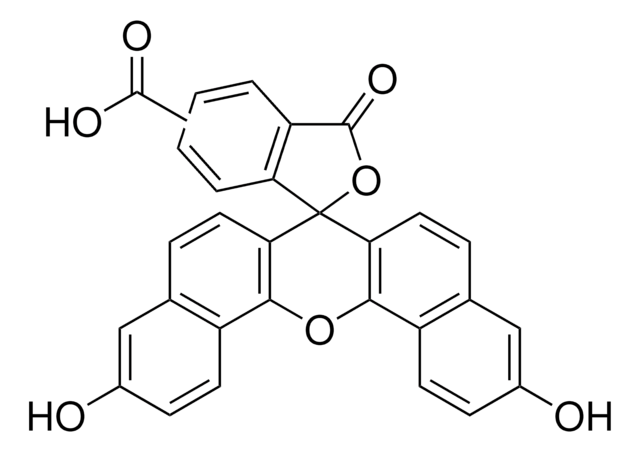21877
5(6)-Carboxyfluorescein
suitable for fluorescence, BioReagent, ≥95% (HPLC)
Sinónimos:
5(6)-FAM, 5,6-CF
About This Item
Productos recomendados
product line
BioReagent
assay
≥95% (HPLC)
form
powder
mp
275 °C (dec.) (lit.)
fluorescence
λex 492 nm; λem 517 nm in 0.1 M Tris pH 8.0
suitability
suitable for fluorescence
SMILES string
OC(=O)c1ccc2c(c1)C(=O)OC23c4ccc(O)cc4Oc5cc(O)ccc35.OC(=O)c6ccc7C(=O)OC8(c9ccc(O)cc9Oc%10cc(O)ccc8%10)c7c6
InChI
1S/2C21H12O7/c22-11-2-5-15-17(8-11)27-18-9-12(23)3-6-16(18)21(15)14-4-1-10(19(24)25)7-13(14)20(26)28-21;22-11-2-5-14-17(8-11)27-18-9-12(23)3-6-15(18)21(14)16-7-10(19(24)25)1-4-13(16)20(26)28-21/h2*1-9,22-23H,(H,24,25)
InChI key
BPVHBBXCESDRKW-UHFFFAOYSA-N
¿Está buscando productos similares? Visita Guía de comparación de productos
Categorías relacionadas
General description
- It has 2 wavelengths for maximum absorbance (465 and 490nm).
- And its fluorescence emission, at 515nm(max.), increases as a function of pH in the physiological range of 6-7.4.
Application
Other Notes
Storage Class
11 - Combustible Solids
wgk_germany
WGK 3
flash_point_f
Not applicable
flash_point_c
Not applicable
ppe
Eyeshields, Gloves, type N95 (US)
Certificados de análisis (COA)
Busque Certificados de análisis (COA) introduciendo el número de lote del producto. Los números de lote se encuentran en la etiqueta del producto después de las palabras «Lot» o «Batch»
¿Ya tiene este producto?
Encuentre la documentación para los productos que ha comprado recientemente en la Biblioteca de documentos.
Los clientes también vieron
Artículos
Nitric oxide (NO) as a signal transporter in neurons, endothelial cells and in the immune system.
Nuestro equipo de científicos tiene experiencia en todas las áreas de investigación: Ciencias de la vida, Ciencia de los materiales, Síntesis química, Cromatografía, Analítica y muchas otras.
Póngase en contacto con el Servicio técnico












